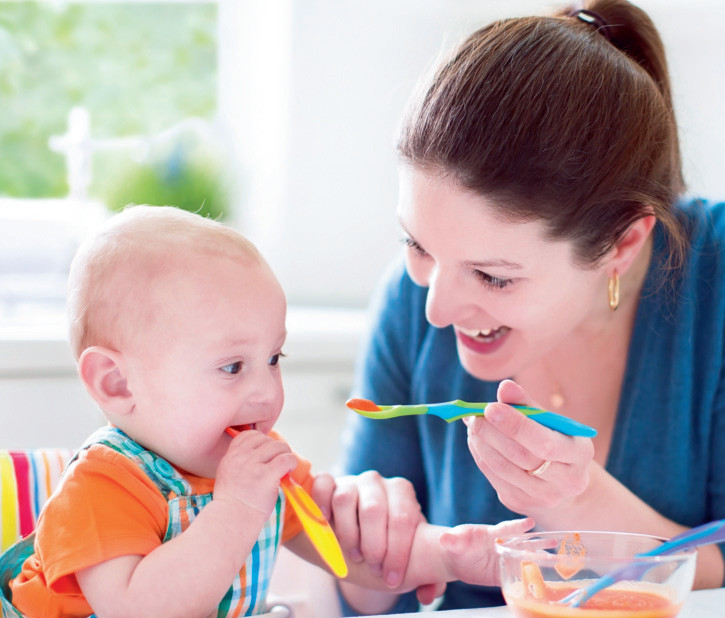Homemade versus ready-made
In Weaning
Follow this topic
Bookmark
Record learning outcomes
Choosing to give babies homemade or ready-made food is often a big decision for parents

Some research has suggested that mums feel a sense of guilt when buying ready-made baby foods. In addition, the research found that mums often buy baby foods out of convenience, as a distress purchase or 'just in case'.
While convenience when out and about is a key benefit of ready-made food, it can also help to offer variety and introduce little ones to new tastes and ingredients. To reassure parents, advise them that ready-made baby foods are specifically designed to meet the nutritional requirements of infants and young children. They are carefully prepared to ensure they provide the right balance of nutrients in appropriate amounts and use high quality, baby grade ingredients to do so.
Parents can check the labels of infant foods to make sure they're happy with the ingredients. When it comes to advising parents, there is no right answer €“ the decision will be whichever works best for the parents, which will usually be a combination of homemade and ready-made food. A huge variety of ready-made foods are available, from cereals to savoury meals as well as desserts and snacks.
All products will have a suitable age range on the packaging, as follows:
From four to six months
Products have a smooth texture so they are suitable for babies just starting to wean. Some are made with only one ingredient so babies can get used to individual tastes.
From six months plus
Products have a slightly thicker texture, and will start to introduce babies to basic proteins such as cheese and to more complex tastes. Parents can also start to introduce meat.
Seven to nine months plus
Products have a mashed texture. Soft, cooked meat such as chicken, and mashed fish can be introduced, as well as pasta, noodles and rice. These foods have different flavours to help develop babies' palates.
10 to 12 months plus
Products contain small, soft chunks and lumps to develop babies' chewing skills.
12 months plus
Products contain much larger lumps of food to further develop the child's ability to chew. Flavours are more adventurous and closer to family meals.
Healthy homemade food can get babies used to the type of food the family eats. When making baby food, it is a good idea to make up batches to provide several portions of the same meal that can be refrigerated or frozen for future use. When preparing food for the freezer, it's important to cool the food down quickly by placing it in an airtight container and holding under a cold running tap, stirring the contents occasionally.
This should be done within one to two hours. Food stored in a fridge should be used within two days and if kept in a freezer, it will need to be used within three months. Food should be thoroughly re-heated (only once) to ensure that it is piping hot all the way through, and then left to cool before feeding the baby.
Did you know?
Eating food from a spoon or fingers requires a different mouth action to that used when drinking free-flowing milk, and may aid speech development.
Tackling fussy eating
It can take a while for babies to get used to a new taste or texture, but if parents are worried that their baby is becoming a fussy eater, you can suggest the following tips:
- Eat the same meals and foods as a family that you want the baby to eat €“ seeing the family enjoy the food will encourage the baby to do the same
- Give small portions and praise the baby for eating, even if they only manage a little
- If the baby rejects the food, don't force them to eat it. Just take the food away without comment. Try to stay calm, even if it's very frustrating
- Don't leave meals until the baby is too hungry or tired to eat
- The baby may be a slow eater, so be patient
- Don't give too many snacks between meals. Limit them to a milk drink and some fruit slices or a small cracker with a slice of cheese, for example
- It's best not to use food as a reward, especially for eating vegetables. Your child may start to think of sweets as nice and vegetables as nasty
- Children sometimes get thirst and hunger mixed up. They might say they're thirsty when really they're hungry and vice versa
- Make mealtimes enjoyable, fun and social, and not just about eating
- If the parent knows other children of the same age who are good eaters, ask them round for tea. A good example can work well
- Sometimes a child will eat for someone else, such as a grandparent, without any fuss
- Children's tastes change. One day, they'll hate something, but a month later, they may love it.
When to refer to the pharmacist
 The following customers should be referred to the pharmacist:
The following customers should be referred to the pharmacist:
- Parents with babies younger than six months who are thinking about weaning
- Those having problems with weaning
- Parents whose babies are having feeding problems (e.g. their baby is not gaining weight, is refusing milk or food, or has any unusual symptoms)
- Parents who think their baby may be allergic to certain foods or who want their baby to follow a vegetarian/vegan diet.
Remember, if parents mention any symptoms or behaviour in a baby that seem unusual or start alarm bells ringing, refer them to the pharmacist.
Further information
- SMA: Food diary
- SMA: Mealtimes
Read all the articles in this section? Now test your knowledge and add this to your learning log.
